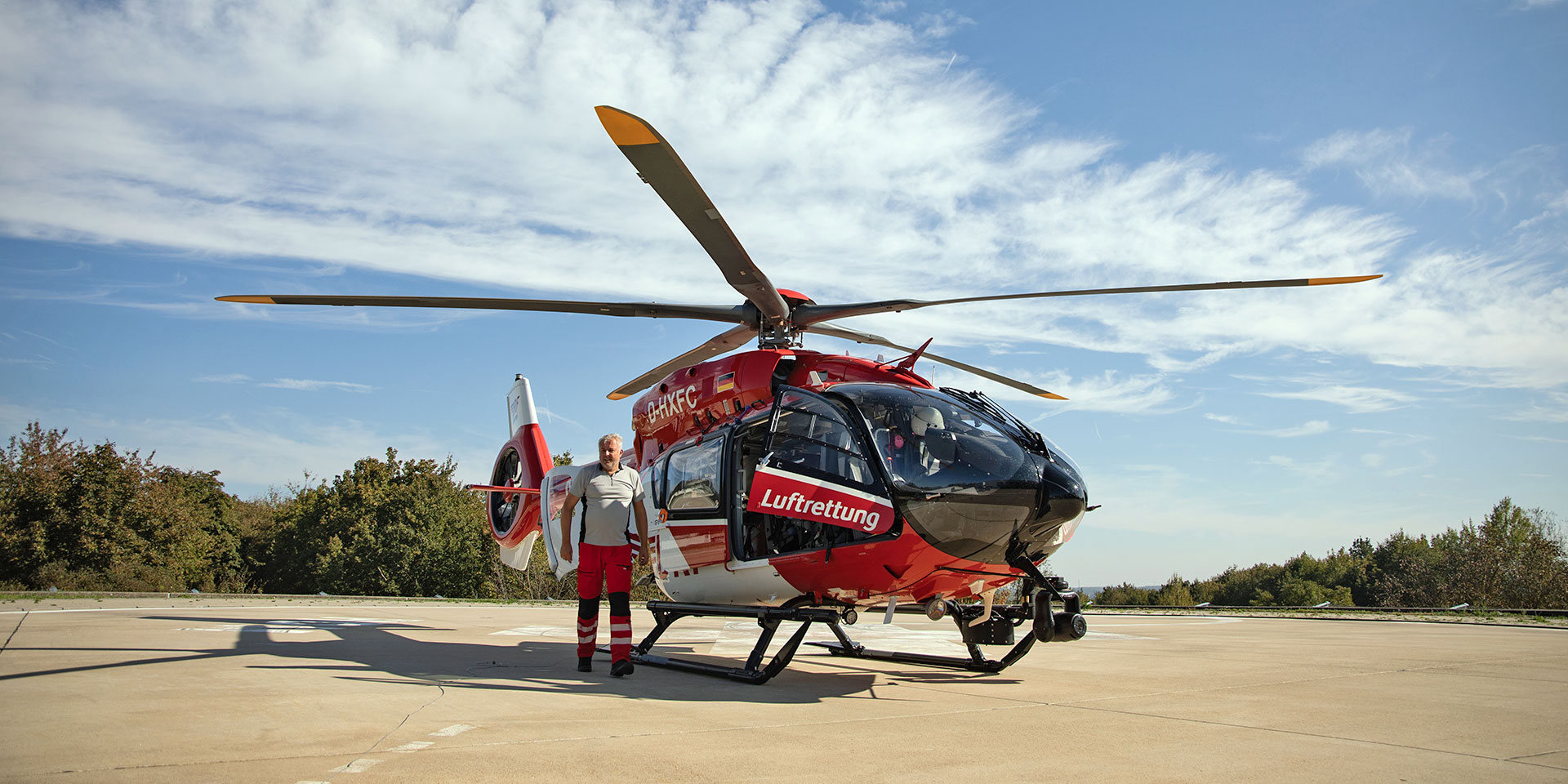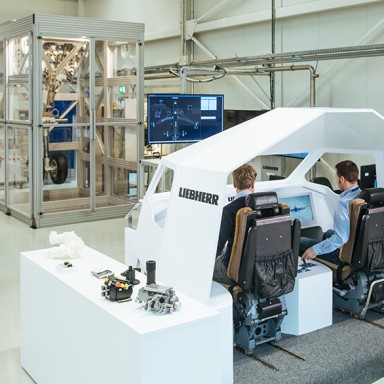
Ultra-precise teamwork: saving lives by helicopter
The alarm sounds for the Christoph Regensburg helicopter of the DRF Luftrettung air rescue service: now, every second counts – and every movement too. Pilot Christian Daxer checks the weather conditions, since the surrounding Regensburg area is often shrouded in mist. In daylight hours, he needs a minimum of 800 m visibility in order to take flight. Once that’s guaranteed, Christian Daxer completes the necessary checks inside the cockpit. He is assisted through this process by a paramedic with additional training. Meanwhile, lead doctor Katrin Judemann inspects the outside of the H145 – an ultra-modern helicopter from Airbus, a company for whom Liebherr technology plays a vital role. Shortly afterwards, the rotor blades start to turn, the doctor climbs aboard and the H145 rises up. Within just two minutes, the machine and its crew are ready for action.
Up in the air, we’re simply faster than on the ground, since there are no bends, no red lights and no traffic jams.
Right of way on the flight path
This series of actions precedes every launch of DRF Luftrettung’s Regensburg-based crew. Routines are important to the station situated at Regensburg University Hospital, especially since the team never knows what to expect at their destination. Contrary to popular belief, helicopter rescues are not the reserve of only very complex emergencies. Ultimately, it comes down to which mode of rescue transport can get an emergency doctor to where they’re needed the fastest. The helicopter has a clear advantage in this regard: ‘Up in the air, we’re simply faster than on the ground, since there are no bends, no red lights and no traffic jams,’ explains Katrin Judemann. She takes great pleasure in flying and in the close bond she has with the rest of the crew. Mutual trust is hugely important, she explains, and this is what glues the team together.

Katrin Judemann, lead helicopter doctor on the Christoph Regensburg, an intensive care transport helicopter
Emergencies and urgent transfers
The emergency responses are by no means always dramatic. Sometimes, the injury is less serious than initially feared or the professional care provided by the team soon has the patient feeling much better. Being a dual-use helicopter, 70 % of the Christoph Regensburg’s deployments are emergency call-outs, with the other 30 % being what are known as secondary deployments. The latter involves flying patients who are already under medical care from one hospital to another: this may be because they need a particular operation or specialist treatment that is only available there. However, these patients may be in a critical condition and the transfer is a matter of urgency. Katrin Judemann prepares for each transfer by discussing the case beforehand with the doctors responsible for the patient’s care.
It is an entirely different approach for incidents involving lots of severe casualties and multiple emergency services, such as the fire brigade. ‘In those instances, it’s really important to give clear commands to ensure everything is coordinated smoothly,’ explains the emergency doctor. Katrin Judemann has extensive experience in such situations. Those working on board the Christoph Regensburg come from the field of anaesthesia, have previously worked in the conventional emergency services and have completed additional training. Due to their experience and their professionalism, the crew does not take every job home with them. That being said, now and again there are incidents that Katrin Judemann can’t put to the back of her mind. ‘That’s when it’s really helpful to speak with the others in the team,’ she explains.
The H145 is state of the art – we’re flying the market leader in the helicopter business.
Specialist technology is vital
Pilot Christian Daxer also greatly values these conversations. He explains that the work is demanding for all those involved, and it calls for resilience and stamina. The pilot has been working for DRF Luftrettung since 2018. Previously, he flew all over the world for air carriers, most recently in the Caribbean. That’s how he knows that by no means all helicopters are up to the job of emergency rescue. The Regensburg model is apparently not only certified, but ‘state of the art’. ‘That means we’re flying the market leader in the helicopter business,’ explains a visibly impassioned Christian Daxer. In his job, you have to have total faith in the technology.
One aspect that’s always challenging is the weather. Christian Daxer gets his information from the German Meteorological Service, as well as numerous webcams distributed between Nuremberg (Germany) and the Czech border. The cloud base determines everything. ‘It’s not so much that pouring rain means I can’t see. We have to be able to avoid the clouds and the wafts of mist,’ explains the pilot. At night, the weather has to be even better than in the day. For added safety, the Regensburg crew fly with two pilots for services after dark. They even use special night-vision goggles.

Christian Daxer, pilot of the Christoph Regensburg
Pinpoint accuracy in challenging terrain
The Christoph Regensburg is on call 24/7, while the crew changes every twelve hours. In daylight hours, manoeuvres in impassable terrain demand maximum concentration. After all, the pilot can rarely expect to find a tarmacked helicopter landing pad awaiting their arrival. The relative proximity to the Danube river and the Bavarian Forest means the Regensburg team often attends rescue operations on the water or in the mountains. Here too, the pilot needs to control the machine with expert precision – without having to contemplate the technology at great length.
This is where Liebherr comes into play. The company supplies control elements, among other things, to the helicopter manufacturer Airbus. Integral to these elements are the actuators: components that convert a pilot’s signal into a control signal for the rotor blades. The rotors of a helicopter always turn at virtually the same speed. To alter the airstream and steer the aircraft, the blades of the main rotor and tail rotor have to be adjusted. And that is the job of the actuators from Liebherr. ‘In aviation, some parts are often technically speaking redundant: if one fails, another takes over its function,’ explains Christopher Fenner, chief engineer for helicopter actuation at Liebherr. ‘But some elements are not doubly integrated, it would be catastrophic if one of those were to fail.’ This includes the actuators. Consequently, they are tested multiple times to make sure that they are completely reliable in their function. Christopher Fenner reports: ‘Even when the analyses show that there are no problems, we still put every part through its paces.’

Christopher Fenner, chief engineer for flight control and actuation systems at Liebherr
Components to take off
This extensive testing is all the more important because a helicopter can be in service for decades, so the parts need to last a long time. In the H145, it’s not just the actuators that this applies to. Liebherr also supplies hydraulic pumps, which ensure the actuators can function, and the gearbox: ‘Everyone recognises that distinctive high-pitched whistling sound of a helicopter’s turbine engine. That’s down to the high rotation speeds. To translate this speed to the rotor speed, our gearboxes are s essential,’ explains Christopher Fenner. This means that, like many other helicopters, the Regensburg helicopter simply would not be able to take off without the products from Liebherr.
Each year, Liebherr delivers over 1,000 different components to manufacturers like Airbus. And that figure is just the assemblies and components, it doesn’t account for every last bolt or washer. Fortunately for the engineers, Liebherr is a company highly driven by innovation – always on the cutting edge and involved in many research projects. At the same time, the company has a bank of expertise amassed over 60 years in the field of aerospace. ‘We don’t start from scratch. If a customer has a specific wish, we generally find a similar product that we can then adapt to meet their individual requirements,’ explains Christopher Fenner.

Danilo Martina, manufacturing engineer at Liebherr
More precise than millimetre work
The need for accuracy at every work step is tremendous. What that means in real terms can be explained by manufacturing engineer Danilo Martina. He works at Liebherr in Friedrichshafen (Germany), where the helicopter gearbox parts are fitted with gearwheels. One of the final steps in production is gear grinding. ‘I align the clamping material and the grinding wheel to thousandth-of-a-millimetre accuracy to ensure the product is the very best quality possible,’ he explains. To meet the safety requirements for aerospace, he cannot allow himself to make mistakes. That’s why Danilo Martina personally checks the dimensions of every component first. Then, he takes the component to the quality department, where it is inspected again and ultimately approved for release.
‘It makes me feel so proud to know that these components can take to the skies and save lives,’ explains Danilo Martina. Engineer Christopher Fenner places great value on the fact that he can play his part in the missions of the Christoph Regensburg and other rescue helicopters. As an amateur pilot in his free time, he occasionally hears reports of helicopters on missions over the airwaves. Perhaps it could even be pilot Christian Daxer and Dr Katrin Judemann on their latest rescue operation. The ability of them and their colleagues to help those in need quickly and in adverse conditions is dependent on the earlier efforts of many hard-working people. After all, successful helicopter missions are reliant on two things: an experienced rescue team and high precision technology that can be trusted to work smoothly every time.
The Liebherr components in the H145






